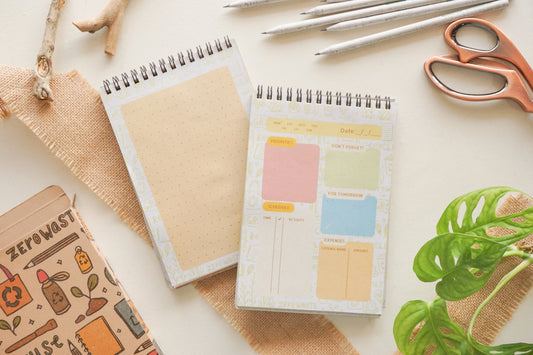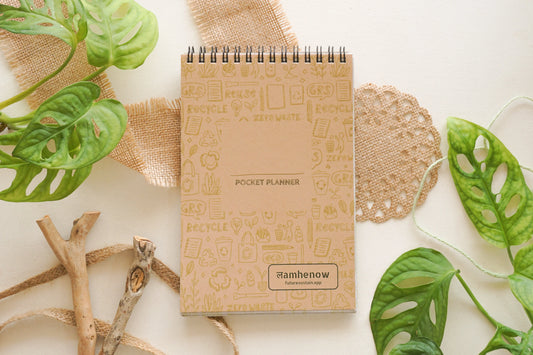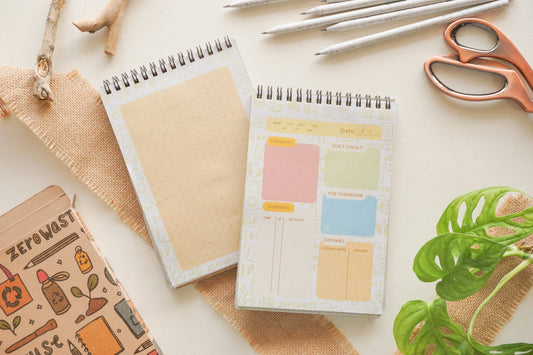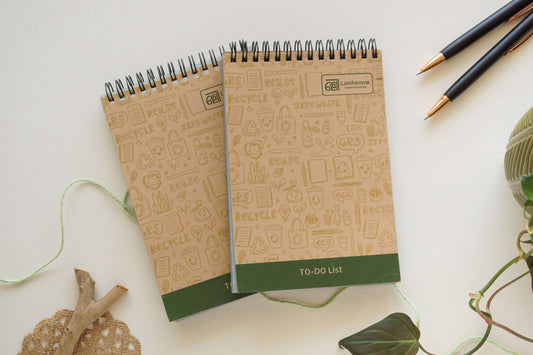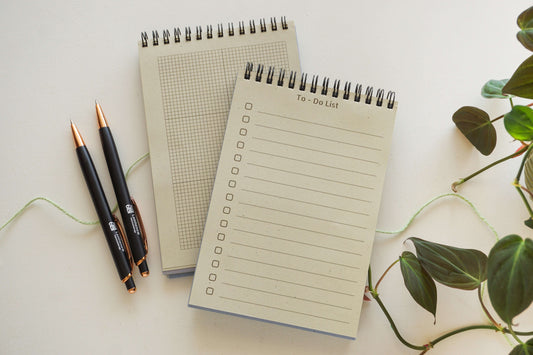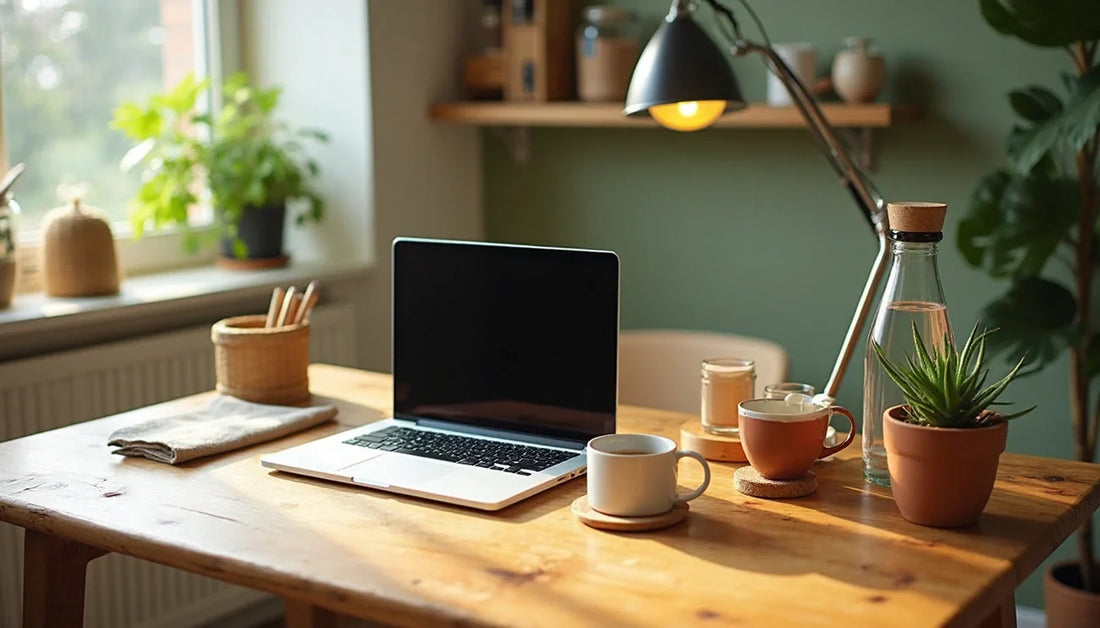
How to Set Up an Eco-Friendly Home Office Without Breaking the Bank
The average office worker goes through 10,000 sheets of copy paper yearly while looking for zero waste office supplies that work effectively.
The numbers paint a concerning picture. People never collect 30% of print jobs, and 45% of printed paper lands in the trash on the same day. These figures don't just represent statistics - they show the environmental damage happening in workplaces across India and beyond.
My journey to reduce waste has been remarkable. By using simple zero waste practices in my home office, I've managed to limit my landfill waste to one tiny bag monthly. This approach not only helps protect our planet but also saves money.
Let's explore practical zero waste office ideas that are cost-effective. We'll look at building eco-friendly daily habits and creating an environmentally conscious workspace. You'll discover everything needed to make your home office green without compromising efficiency or comfort.
Build Sustainable Habits First
Daily green habits sustainable daily habits lay the groundwork for an eco-friendly home office, even before buying new products. These habits won't cost you anything but will substantially reduce your environmental footprint.
Your priority should start with managing food waste. The EPA's data shows that decomposing food creates almost 60% of all methane emissions in landfills. Smart meal planning and proper leftover storage make a big difference. Glass, bamboo, or stainless steel containers last nowhere near as long as their disposable plastic counterparts.
Stackable containers help maximize your fridge's space. Food stays fresh longer in airtight containers with silicone rims, which helps cut down waste. A sparkling water maker can eliminate the need for disposable bottles completely.
Coffee pods often end up in landfills, so it's best to avoid them. The same goes for takeout - tell restaurants to skip the plastic utensils, napkins, and extra sauce packets. These simple changes prevent waste without spending extra money.
A strong recycling system that follows local rules helps cut carbon emissions and reduces landfill waste. Composting becomes especially valuable with large offices or those near food businesses. The ideal indoor composting bin should be 15-gallon with a foot-operated lid, and needs emptying once or twice daily to keep odors away.
Office supplies need a minimalist touch. Buy what you need instead of storing excess. Team up with colleagues or friends to split bulk purchases of special items. Many supplies can come from reusing incoming mail materials.
These zero waste ideas need little investment but make a big environmental difference. Better yet, eco-friendly habits become automatic over time, creating a naturally green workspace.
Set Up a Low-Cost Green Workspace
Image Source: Greener Ideal
You don't need expensive renovations or specialty products to create an eco-friendly workspace. Smart choices help you build a green office that's budget-friendly and good for the environment."Use furniture that is made from renewable and responsibly sourced materials. Wood is a perfect example." — Jacky Xu, Chief Operating Officer at Maid Sailors
Your choice of lighting affects both energy use and workspace comfort significantly. LED bulbs use up to 90% less energy and last up to 25 times longer than traditional incandescent options. Switching to LED lighting saves the average household about INR 18,985.60 in energy costs each year. Natural light works best, so place your desk near windows to cut down on artificial lighting during the day.
Here are some eco-conscious furniture options to think about:
- Second-hand or refurbished pieces that prevent additional manufacturing waste
- Items made from recycled materials like reclaimed wood or recycled metal
- Bamboo furniture, which grows faster and needs minimal processing
Indoor plants do double duty - they clean your air and boost your mood and creativity. Snake plants or pothos thrive with minimal maintenance, making them perfect even if you're not great with plants.
Lamhenow makes zero waste office supplies that work perfectly in an Indian home office. Their recycled paper notebooks and planners come with Global Recycled Standard certification and use 80 GSM recycled paper. Daily planning and note-taking become eco-friendly with their 100-page wiro-bound notepads.
Refillable writing tools save money over time. You can minimize paper use by storing files digitally whenever possible.
Keep your workspace fresh with non-toxic cleaning products. Biodegradable options protect your health and the environment effectively.
Unplugging electronics and chargers when not in use makes a difference. Energy efficiency standards show that vampire power (electricity used by plugged-in but turned-off devices) takes up much of home electricity usage.
These simple changes create an environmentally responsible workspace that boosts productivity without hurting your budget. This proves that sustainability and affordability definitely work together.
Encourage a Zero Waste Office Culture
Image Source: Sustainably Sorted
"Remember and implement the 5Rs: Reduce, reuse, recycle, repair, and refuse." — Jacky Xu, Chief Operating Officer at Maid Sailors
Creating a zero waste mindset needs more than personal commitment—it thrives on building a supportive community of like-minded colleagues. Studies reveal that 77% of commercial office waste could be recycled or composted, yet it ends up in landfills. You can reshape the scene by putting together a dedicated sustainability committee.
Start with a "Green Team" of passionate volunteers who will lead eco-friendly initiatives in your workspace. Your team should have people from various departments to bring different points of view. The David Suzuki Foundation puts it well: "People don't check their values at the door when they leave home for work each day". This team can lead waste reduction campaigns, run educational workshops, and track progress toward sustainability goals.
A centralized waste collection system makes a big difference. Research shows that switching from personal desk bins to central collection points increases recycling rates. This setup works because people think twice about what they throw away instead of tossing items without thought.
A waste audit helps set your starting point. Team members can track the types of organic materials your office produces. This information helps you make targeted improvements.
Indian offices can start with these practical steps:
- Set up clearly labeled central stations for recycling, composting, and landfill waste instead of personal bins
- Switch to digital documents and use Lamhenow's recycled paper products only when printing is needed
- Create composting systems for food waste, especially in offices with cafeterias
Regular celebration of sustainability wins keeps the momentum going and gets more people to participate. Yes, it is true that employees participate more at work when they're part of sustainability initiatives.
Cultural change takes time. Start with small, achievable goals that show quick wins. You can take on bigger projects as your zero waste office culture grows stronger.
Conclusion
You can create an environmentally responsible home office that's both achievable and affordable. This guide explores practical approaches that reduce environmental effects without compromising productivity or exceeding your budget.
Environmentally responsible habits are the foundation of a truly green workspace. Your carbon footprint drops significantly with simple daily choices like managing food waste properly and consuming mindfully - all at zero cost. A thoughtful workspace setup with your desk near natural light, LED bulbs, and air-purifying plants creates an environment that serves both you and the planet.
Indian professionals can find perfect alternatives to conventional stationery in Lamhenow's recycled paper notebooks and planners. These GRS-certified items deliver the functionality you need while arranging with your environmental goals. Your eco-friendly choices often lead to financial savings through lower energy use and fewer replacement purchases.
Working alone or with colleagues, you can promote a zero waste culture that multiplies your individual effect. Everyone stays motivated when they participate in waste audits, use centralized collection systems, and celebrate sustainability milestones regularly.
Keep in mind that your eco-friendly office experience doesn't demand perfection - it runs on steady improvement. Every small step adds to meaningful change. Environmentally responsible workspaces boost our wellbeing, productivity, and connection to meaningful work. Your choices today make a genuine difference to India's environmental future, so start with whatever resources you have.
FAQs
Q1. How can I set up an eco-friendly home office on a budget? Start by maximizing natural light, using LED bulbs, and incorporating recycled or second-hand furniture. Choose energy-efficient appliances, use reusable containers for meals, and opt for eco-friendly office supplies like recycled paper notebooks. These small changes can make a big impact without breaking the bank.
Q2. What are some sustainable daily habits I can adopt in my home office? Build sustainable habits by planning meals to reduce food waste, using reusable containers and water bottles, setting up a proper recycling system, and adopting a minimalist approach to purchasing office supplies. These habits cost nothing but significantly reduce your environmental impact.
Q3. How can I encourage a zero waste culture in my workspace? Form a "Green Team" to champion eco-friendly initiatives, implement a centralized waste collection system, conduct waste audits, and digitize documentation processes when possible. Celebrate sustainability achievements regularly to maintain motivation and engagement among colleagues.
Q4. What are some affordable eco-friendly alternatives for office supplies? Look for products made from recycled materials, such as recycled paper notebooks and planners. Replace disposable writing instruments with refillable options. Consider digital file storage to minimize paper usage. These alternatives are often cost-effective in the long run and better for the environment.
Q5. How can indoor plants contribute to an eco-friendly home office? Indoor plants serve dual purposes by improving air quality and enhancing mood and creativity. Even low-maintenance options like snake plants or pothos can thrive in office environments. They're an affordable way to make your workspace more eco-friendly while also boosting your well-being and productivity.

